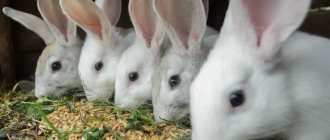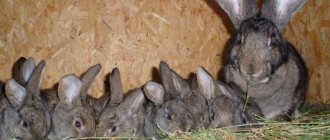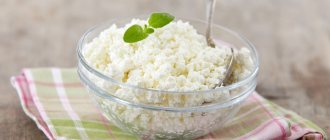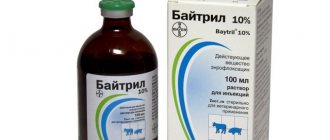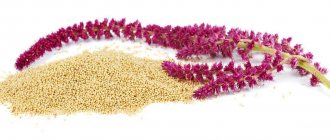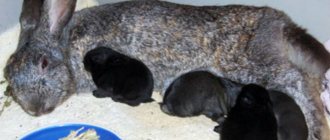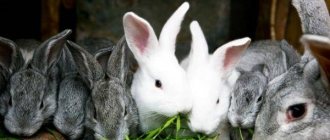Author of the article
Guryev Evgeniy Valerievich
Rabbit breeder with 22 years of experience
Articles written
0
In order for rabbits to grow healthy and gain weight well, they need adequate nutrition. It is difficult to overestimate the role of grain included in their diet. The value of cereals, which are classified as concentrated feed, lies in their nutritional value, as well as the high content of proteins, carbohydrates, vitamins and microelements.
Another advantage is the economic availability of this type of food. However, not all grains are equally beneficial for rabbits. Therefore, it is necessary to study what grain to feed rabbits, at what period of their life and in what quantity.
Digestive system of rabbits
The animals eat coarse food with the help of their incisors, and they crush it with their molars. After exposure to saliva, food becomes soft and is safely sent down the esophagus directly to the stomach.
The musculature of the walls of the monocavitary stomach of rabbits is thin and flabby. This guarantees the absence of gag reflexes in animals. But there is also a negative side - if a rabbit eats something inappropriate for itself, its stomach will stop functioning, which can lead to unpleasant consequences, including death.
The size of the internal organs also has its own peculiarity. Swallowed food reaches the duodenum, which is twelve centimeters long, only in a period of time from one hour to seven hours. An underdeveloped intestine does not have peristalsis, which would take on the function of moving food into the stomach.
Only a new portion of it pushes through the swallowed food. Therefore, rabbits should receive food, including grain products, frequently. Pets should always have food in their feeder; starvation is unacceptable for them.
You can read about the features of feeding pregnant rabbits in our article.
Composition of feed for rabbits
Both complete rabbit feed and concentrates have approximately the same composition. The difference between them lies only in the different quantities of these components.
The basis for any combined feed is grain. Most often, ground corn, wheat, barley and oats are used for its preparation. Moreover, several types of grains are usually included in one mixture. This allows you to make food more nutritious and healthy.
In addition to cereals, complete formulations and concentrates may also include:
- wheat bran;
- finely chopped dried herbs;
- meal;
- chopped vegetables;
- chalk;
- hay;
- salt;
- feed yeast;
- bone flour.
Reference. The nutritional components of feed are often supplemented with antibiotics, which provide the prevention of various infectious diseases, and vitamin supplements.
The main listed composition may vary greatly among different product manufacturers. There are no specific officially accepted standards for the presence of certain components in the mixture. The main document that manufacturers rely on is GOST. But, it only regulates the amount of protein, amino acids, nutritional value and other general points.
Benefits of Grain Feeding
Grains go well with the rabbits' digestive system. They are able to push through previously eaten food well.
The grain is well digested by the digestive system of rodents. The availability of grain for rabbits is of particular importance in winter, when it is not possible to feed them fresh grass. The most important grain crops for feeding rabbits are wheat, oats and barley. Corn can also be counted among them.
Animals eat them with great appetite, and purchasing this type of grain is not a big problem for rabbit breeders. Each type contains its own set of valuable nutrients, so rabbits should include all of these varieties in their diet.
Please note that feeding rabbits exclusively with grain is unacceptable. In summer, the diet must include fresh grass, vegetables and fruits, and in winter, hay prepared for future use. Compound feed that has a balanced composition is widely used.
When feeding only greens and vegetables, it will be impossible to achieve rapid weight gain in rabbits, which is especially important when raising meat breeds. Easily digestible grain makes the diet complete and prevents gastrointestinal diseases.
Another advantage of grain crops is that they do not spoil, so they can completely fill the feeder.
Types and meaning of grain mixture
Depending on the number and type of animals raised, the owners face an important task: choosing and preparing nutritious food for every day. In summer, this issue is resolved relatively easily: there is a lot of fresh grass and vegetables. In winter or early spring there is no such possibility, and without all the necessary substances the animals will quickly die. The solution may be to purchase ready-made dry food, which is classified into three types.
Feed additives are usually used to provide rabbits with vitamins and all necessary microelements. Such mixtures are not given separately, but are mixed in certain proportions with the main feed. The advantage of supplements will be ease of use and the ability to independently control the amount of substances supplied. The only disadvantage will be the cost and the need for constant acquisition, which is also not always possible.
A description of the butterfly breed can be found here.
Feed concentrates usually contain all the necessary elements in a “condensed” form. They are not used as independent food, but are added to the diet of roughage and succulent feed. Concentrated feed also needs to be purchased, which is not always justified from the point of view of the profitability of cultivation.
Characteristics of the Risen breed are presented here.
Complete feed is compound feed in the full sense of the word. This type of mixture completely satisfies all the animals’ needs for nutrients and vitamins. Compound feed is very convenient to use, furry pets readily eat it and it is much more economical than conventional mixtures.
Unlike grain, it is completely digestible by animals; its structure allows for additional grinding of teeth, which is a problem for most rodents. In addition, when using combined complete formulas, the animal gains weight faster and gets sick less, since its diet contains all the substances necessary for full development.
Find out what the white giant breed looks like by following the link.
Using feed for rabbits helps:
- Gain weight quickly for animals.
- Avoid many common diseases.
- Optimize feed supply.
- Save time and money.
- Provide a nutritious diet.
At its core, compound feed replaces the basic nutrition of animals. Judging by the description of the Gray Giant rabbit breed, to provide everything necessary, you just need to establish round-the-clock access to clean water, as well as give the rabbits enough fresh grass or hay. This method is also suitable in case of lack of time, as well as in case of forced absences from home or constant employment. The composition of the feed is varied and high in calories, so the animals will not need anything.
Which grain to choose
Wheat
Nutritious cereal has a positive effect on the health of rodents. During the growth period, wheat promotes rapid weight gain. It contains a large amount of proteins, carbohydrates, fats, vitamins B and E.
Wheat has a high nutritional value, so there is a limitation - its amount should not exceed 25-30% of the total amount of feed given. Increased consumption of wheat will increase the formation of gluten in the stomach, which can cause bloating and metabolic disorders.
Oats
This cereal contains a large amount of pantothenic acid, which keeps rabbits' bodies in good shape. It also helps to improve the reproductive function of animals. Oats are a natural antioxidant, so it is advisable to include them in grain mixtures so that the body can cleanse itself of toxins.
Despite the fact that oats have a high calorie content, they do not cause obesity in rabbits, so they can make up 50% of the total composition of the food given.
Oats contain proteins, fats, and carbohydrates. It also contains zinc, manganese, copper, cobalt, vitamins B1, B5, B6. This culture is the best option for feeding rabbits.
Barley
Barley is a more nutritious cereal crop than oats. It is very beneficial for the digestive system of rabbits. Barley is recommended to be given to nursing rabbits and young animals in need of increased nutrition. It also promotes rapid weight gain.
Substances such as lysine and choline found in barley improve the overall well-being of animals. Barley grains also contain potassium, calcium and B vitamins. The outer shell of the grains is difficult for the stomach of rodents to digest, so it is recommended to remove it by grinding before feeding.
Barley should be limited during the period when rabbits are being prepared for mating. The nutritious product can lead to obesity, which will negatively affect the state of reproductive function.
Corn
This cereal is not high in calories. Corn contains large quantities of carbohydrates, carotene, phosphorus, potassium, magnesium, iron, vitamins E, B1, B2, PP.
However, protein and calcium are contained in this cereal in limited quantities. Long-term feeding of corn is not recommended as it can cause unwanted obesity in rabbits.
How, why and in what form to give wheat to rabbits?
If you are a beginning farmer and don’t know whether it is possible to feed rabbits with wheat, then you need to understand that this grain crop is rich in nutrients that are vital for rodents. But first you have to learn the rules of feeding.
Benefits and harms
Wheat contains a large amount of carbohydrates (up to 75%), proteins, fats, protein, dietary fiber, vitamins E, K, B, C, A, as well as a group of minerals - phosphorus, calcium, zinc, iron, potassium, manganese, magnesium and sodium. Therefore, it has the following properties:
- fills the body with energy;
- normalizes the functioning of the digestive system;
- speeds up metabolism;
- strengthens the immune system;
- cleanses blood vessels from cholesterol;
- removes harmful substances;
- strengthens the cardiovascular system;
- promotes the proper distribution of nutrients in the body.
Thus, by consuming this grain, the rabbit will grow healthy and energetic. But wheat is famous not only for its beneficial properties.
It turns out that it is extremely important for rodents to gnaw on grains, since they contain abrasive particles, thanks to which the teeth are ground down, which, in turn, prevents their too rapid growth and the occurrence of pathologies such as malocclusion
The nutritional value of grain is 360 Kcal/100 grams, so the dosage must be strictly observed. Otherwise, the rabbit will develop obesity, which will negatively affect the functioning of internal organs.
If you overfeed an animal with wheat, you can harm it:
- Wheat contains gluten, which in large quantities leads to flatulence (bloating).
- Grain does not contain absolutely all vitamins and microelements, so if you do not diversify the menu and feed your pet only wheat, an imbalance of nutrients occurs. Read more about what vitamins rabbits need and what foods to get them from here.
- In case of an overdose, the body's absorption of minerals is blocked, since the cereal contains phytates (antinutrients).
Rules for feeding grains
Cereals are very useful for feeding rabbits, but it is necessary to regulate their intake by rodents. Feeding rabbits with grain requires compliance with certain rules.
Pre-processing the grains will improve digestion and allow for better absorption of nutrients. The most commonly used methods include crushing, sprouting, steaming and yeasting.
Expert opinion
Dobryshev Sergey Anatolievich
Professional rabbit breeder with 30 years of experience
IMPORTANT! When introducing grain crops into the diet of rabbits, a constant supply of fresh water must be ensured.
Before purchasing a product, a visual inspection is necessary - the grains must be clean and have the correct shape. There should be no oily film on the surface.
How much grain does a rabbit need per day?
Grain in the diet of rabbits should account for up to 45% of the total diet. The exact dosage is determined taking into account the age and breed characteristics of the eared animals.
- Adults weighing up to 5 kg - 50–60 g of grain per day.
- Pregnancy, childbirth, lactation or mating period - up to 100 g.
- Young animals - 50 g of grain per day.
- Decorative pets - 1 tbsp. l. cereals for a day.
- Young stock: ½ wheat+1/4 barley+1/4 corn.
- Lactating rabbits: ½ oats + ½ barley.
- Breeding males: ¼ wheat + ¾ oats.
It is impossible to give long-eared grains only whole grains, since they are difficult to digest and can harm the health of the animals. It is also forbidden to feed animals only one type of grain, because there will be a shortage of some microelements and an excess of others. Therefore, it is definitely worth preparing grain mixtures from different cereal crops.
Video which grain is best for rabbits
Grain crushing
It is convenient to use a grain crusher to crush grain. You can buy it in a store or make it yourself.
To carry out the process at home, you should purchase a household-type grain crusher. The use of this technique will significantly simplify the process of preparing grain for feeding rabbits.
When choosing a grain crusher, you need to take into account productivity, grinding degree, power, manufacturer and price. You can make your own grain crusher from a grinder.
Daily intake of feed for rabbits
There are scientifically based standards for feeding rabbits with compound feed. They are usually indicated on the packaging in which such products are sold. Dosages are calculated for each age group, and also depend on the composition of the mixture, the physiological state of the living creature, breed and a number of other parameters.
The most generalized norms for animal consumption of a complete mixture are as follows:
- for young animals aged 1.5-2 months, the fed volume is 140 g per day;
- rabbits from 2 to 3 months are given 205 g;
- a rabbit at 3-4 months eats 270 g of mixture per day;
- young individuals from the replacement herd are fed no more than 200 g per day;
- animals used for breeding consume about 180 g during the resting period;
- breeding rabbits are given up to 230 g during the mating period;
- The recommended amount for female rabbits during pregnancy is no more than 180 g.
It is worth noting that for the period of milk feeding, from 170 to 700 g of PC are allocated to the female rabbit and her offspring (the figure depends on the number of rabbits and the breed).
When feeding pets with such formulations, it is also important to consider some rules:
The drinking bowl should always be full
- The animal must have plenty of fresh, clean water in its drinking bowls.
- Young animals are fed at least 6 times a day. For adults, 2-3 meals will be enough.
- When combining different types of feeding, it is necessary to strictly follow the schedule. Concentrates and complete feeds are given in the morning and evening, when they are more easily absorbed by the digestive tract of the animals. It is better to leave rough and juicy food for the daytime.
Germination
Sprouted grain is eaten by rabbits with great pleasure and is well absorbed by them. When germinated, the nutritional value of the grain increases.
The germination process consists of the following stages:
- Rinse the grain with warm water. The amount of grain depends on the need.
- Collect empty shells that float to the surface and discard them.
- Prepare a container for germination. Boxes, baking sheets, and pallets can be used as them.
- Pre-soak the grain to swell with a small amount of water and place it in a warm place for a day.
- Remove excess moisture.
- Place the swollen grains in germination containers on a thin, moistened layer of soil.
After a few days, small sprouts will appear, which can be used to supplement animal food.
Daily intake of feed for rabbits
There are scientifically based standards for feeding rabbits with compound feed. They are usually indicated on the packaging in which such products are sold. Dosages are calculated for each age group, and also depend on the composition of the mixture, the physiological state of the living creature, breed and a number of other parameters.
The most generalized norms for animal consumption of a complete mixture are as follows:
- for young animals aged 1.5-2 months, the fed volume is 140 g per day;
- rabbits from 2 to 3 months are given 205 g;
- a rabbit at 3-4 months eats 270 g of mixture per day;
- young individuals from the replacement herd are fed no more than 200 g per day;
- animals used for breeding consume about 180 g during the resting period;
- breeding rabbits are given up to 230 g during the mating period;
- The recommended amount for female rabbits during pregnancy is no more than 180 g.
Yeasting
To quickly gain weight in a rabbit, it is recommended to feed grain prepared by yeast. To carry out this process you need:
- grind grain;
- Dissolve nutritional yeast in clean water;
- Fill the container with grain with warm water;
- add yeast solution at the rate of 36 grams of yeast per two liters of water;
- stir and leave to ferment.
The fermentation process takes from six to nine hours. During this period, it is necessary to constantly stir the mixture. Rabbits are fed by adding grain that has been fermented to the total mass of feed, 2-3 tablespoons per serving.
Cooking methods
You can prepare grain for feeding rabbits using several methods: steaming, yeasting, germination, crushing.
Before you start cooking, be sure to inspect the grains used:
- The grains should not contain dirty seeds, small stones and green unripe grains. You also need to pay attention to the presence of small insects or fungal spores; they should not get into the food of rabbits.
- If black spots are visible on the grains, they should not be used to feed animals.
- Do not feed overdried or raw grain to rabbits.
IMPORTANT! Experienced breeders use one-year-old grains. You should avoid purchasing crops that can be stored for a longer period.
Cereals must be steamed before serving to rabbits.
Steaming
Steaming is the simplest and at the same time very effective way of preparing grain crops for feeding rabbits.
For steaming, take grains of one type or pour the prepared mixture of cereals into a bucket or other container, but not to the very edge, since during the steaming process the volume of the resulting mass will increase. The grain is poured with boiling water. You need to add 1 tbsp to the water. salt, then stir the mixture and cover lightly with a lid. The container should be left in this form for 5 hours. During this time, the grains will swell and can be used for feeding.
Steamed grains become soft and sweet, the digestive system of animals copes better with such food, and nutrients are absorbed faster. Rabbits eat this food with pleasure.
IMPORTANT! It is highly undesirable to feed rabbits rice and boiled porridge. Also, the animals’ diet should not contain bread or other sweet products. These products cause fermentation processes in the intestines and bloating.
Yeasting
This method of preparing feed is used to accelerate the growth rate of animals and rapid weight gain. It can be used for rabbits starting from 4 months of age. Preparation proceeds as follows:
- The grains are ground and mixed in a container with water in a ratio of 1:2.
- Yeast is diluted in water at the rate of 36 g per 2 liters of water.
- All components are thoroughly mixed and left overnight.
- The whole process takes about 6-9 hours. From time to time the mass needs to be stirred.
When feeding, add 2-3 tablespoons of yeast mixture to the dry cereal mixture at each meal. This regime is maintained for 5 days, after which the food is changed.
Sprouted grains are much healthier than dry grains
Germination
Sprouted grains are much healthier than dry grains due to the fact that during the germination process they release beneficial substances that are not absorbed by the body when dry grains are consumed. Swollen fiber perfectly cleanses the animal’s intestines, removing accumulated waste products from the body, and also increases the body’s protective functions.
When preparing food, you need to pay attention to the following points:
- The grains selected for cooking should be pre-washed in warm water. If you immerse grains in water, you will notice that some of them float to the surface. Such grains cannot be used as food for rabbits; they are already considered dead.
- The grains should be washed several times to prevent fungal spores from getting into the feed. During the growth of grain crops, enzyme poisons are released that are detrimental to animal health.
- If silver water is used when washing grain, and not ordinary drinking water, then there is no need to repeat the procedure several times.
If food needs to be prepared for a small number of animals, then you can germinate the grains in a plate, placing them in a damp cloth, and you need to regularly add water to the grains to maintain the moisture level. On large farms, feed is prepared in buckets, filling the grains with water up to 2 cm from the edge.
The whole process consists of the following steps:
- The grains filled with water are left for 12 hours, during which time they will swell well.
- After 12 hours, the grains are transferred to plastic bags, in the bottom of which holes should be cut so that all excess moisture is drained from the grains.
- The bags are placed in a warm place. The grain layer should not be higher than 8 cm.
- The mixture can be fed to rabbits when sprouts become visible in it.
IMPORTANT! If the mixture has darkened, it cannot be used for feeding.
Crushed grain
Another method of preparing feed is crushing. You can purchase the cereal mixture in this form, or you can prepare it yourself. To do this, you just need to grind the prepared culture. Typically, corn is crushed, but oats, wheat or barley can also be prepared this way.
How to feed grain mixtures to rabbits
Rabbits can be offered either each type separately or mixtures of them. This is reasonable, since each type of grain crop contains a certain set of nutrients, vitamins and minerals. When feeding with formulas, nutrition will become more balanced. It is also recommended to add bran to the mixture.
When preparing mixtures, it is necessary to take into account the age of the rabbits and their physical condition. For adult individuals, the following ratio is suitable: oats - 40%, wheat and barley - 20% each, corn and bran - 10% each.
When feeding meat rabbits, the proportion of barley should be increased to 40%, wheat – 20%, corn and oats – 15% each, and the remaining 10% should be left for bran. During the period of their accelerated growth, young animals should be offered a grain mixture in the following proportions: oats and corn - 30% each, barley and bran - 15% each, wheat - 10%.
These recommendations are indicative and can be adjusted by rabbit breeders. The inclusion of grain mixtures in animal diets depends on the season. This becomes most important in winter, when there is no possibility of feeding animals with fresh herbs.
Main components of grain mixtures. Corn.
Barley is considered the most versatile. Thanks to a unique set of nutritional components, it is suitable for all categories of rabbits: babies and adults, pregnant and lactating females. If you feed only one grain, then it is best to stop at barley. It is eaten with great appetite and does not create digestive problems even with constant access to food.
Wheat is just as versatile, even more high in calories. Although this may be a disadvantage. More precisely, rabbits, when fed uncontrolledly, overeat and gain fat. For fatteners it may not be bad, but for others it’s a big problem with reproduction. In addition, overeating wheat grains can cause bloating.
Oats , as the opposite of wheat, are easily digested, improve digestion, and do not cause obesity. Very useful for breeding rabbits, increasing reproductive functions. However, it is inferior in calorie content. For the normal development of the animals, it is necessary to mix other grains with barley or alternate with it.
, corn is the leader among the listed types of grains. Overeating is even more dangerous. But in reasonable quantities (as part of a grain mixture) it will have a beneficial effect on females that are in water or lactating, due to the rich presence of fats. In its pure form or in heads of cabbage, polho is eaten by children and burdens the gastrointestinal tract.
Peas are rich in proteins and fats, but are difficult to digest. Under-dried beans can cause upset. But, if given correctly, the benefits are enormous. Indicated for females, as it improves lactation (milk production) and supplies building material for the formation of embryos. The young animals are gaining weight well. It is best to steam crushed peas (as part of a grain mixture, mash, or even separately).
Zolotukhin method for feeding rabbits
The famous rabbit breeder has extensive experience in successfully raising rabbits, which he willingly shares with everyone. He offers the following scheme for feeding rabbits with grain crops:
- Little rabbits who are just beginning to get used to adult food after a period of milk feeding are given brewed oats.
- After some time, crushed oats begin to be added to food in small portions.
- After reaching the age of four months, the young animals begin to be given crushed corn.
- Rabbits should be given whole oats during the period of feeding their young rabbits with milk.
- Crushed barley should be given to rabbits before mating, as well as to pregnant rabbits before the imminent birth.
- After six months of age, males should be given a mixture of oats, barley and a small amount of corn.
If you follow the rules proposed by Zolotukhin, you can get healthy and well-fed rabbits.
Composition of feed for rabbits
Both complete rabbit feed and concentrates have approximately the same composition. The difference between them lies only in the different quantities of these components.
The basis for any combined feed is grain. Most often, ground corn, wheat, barley and oats are used for its preparation. Moreover, several types of grains are usually included in one mixture. This allows you to make food more nutritious and healthy.
In addition to cereals, complete formulations and concentrates may also include:
- wheat bran;
- finely chopped dried herbs;
- meal;
- chopped vegetables;
- chalk;
- hay;
- salt;
- feed yeast;
- bone flour.
Reference. The nutritional components of feed are often supplemented with antibiotics, which provide the prevention of various infectious diseases, and vitamin supplements.
The main listed composition may vary greatly among different product manufacturers. There are no specific officially accepted standards for the presence of certain components in the mixture. The main document that manufacturers rely on is GOST. But, it only regulates the amount of protein, amino acids, nutritional value and other general points.
What you need to know about proper feeding
Grain must be given in accordance with feeding standards. But in what form it should be given, opinions are divided. A number of experts say that it can be given in dry form, while others are of the opinion that it is better to use crushed grain.
As for wheat and oats, they have a fairly soft consistency, and therefore do not need to be pre-processed in a crusher or filled with hot water. At the same time, rabbits eat this food well.
Another nuance of feeding is the age group of the animals. It is recommended to provide young animals with grain mixtures consisting of 50% wheat. The rest comes from corn and barley.
It is best to give rabbits nursing offspring 50% oats and the same amount of barley. These crops have high energy value.
Breeding males at work are fed wheat and oats in a ratio of 1/4 to 3/4.

